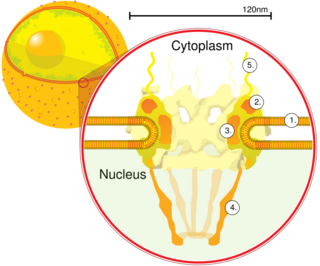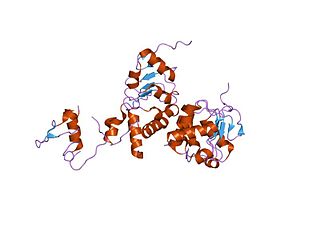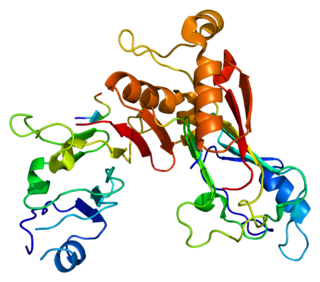Nucleoporin GLE1 is a protein that in humans is encoded by the GLE1 gene on chromosome 9. [4] [5] [6]
Nucleoporin GLE1 is a protein that in humans is encoded by the GLE1 gene on chromosome 9. [4] [5] [6]
This gene encodes a predicted 75-kDa polypeptide with high sequence and structure homology to yeast Gle1p, which is nuclear protein with a leucine-rich nuclear export sequence essential for poly(A)+RNA export. Inhibition of human GLE1L by microinjection of antibodies against GLE1L in HeLa cells resulted in inhibition of poly(A)+RNA export. Immunoflourescence studies show that GLE1L is localized at the nuclear pore complexes. This localization suggests that GLE1L may act at a terminal step in the export of mature RNA messages to the cytoplasm. Two alternatively spliced transcript variants encoding different isoforms have been found for this gene. [6]
A genome-wide screening and linkage analysis assigned the disease locus of lethal congenital contracture syndrome, one of 40 Finnish heritage diseases, to a defined region of 9q34, where the GLE1 gene is located. [7] Mutations in GLEI have been identified in families with foetal motoneuron disease. [8]

A nuclear pore is a part of a large complex of proteins, known as a nuclear pore complex that spans the nuclear envelope, which is the double membrane surrounding the eukaryotic cell nucleus. There are approximately 1,000 nuclear pore complexes (NPCs) in the nuclear envelope of a vertebrate cell, but it varies depending on cell type and the stage in the life cycle. The human nuclear pore complex (hNPC) is a 110 megadalton (MDa) structure. The proteins that make up the nuclear pore complex are known as nucleoporins; each NPC contains at least 456 individual protein molecules and is composed of 34 distinct nucleoporin proteins. About half of the nucleoporins typically contain solenoid protein domains—either an alpha solenoid or a beta-propeller fold, or in some cases both as separate structural domains. The other half show structural characteristics typical of "natively unfolded" or intrinsically disordered proteins, i.e. they are highly flexible proteins that lack ordered tertiary structure. These disordered proteins are the FG nucleoporins, so called because their amino-acid sequence contains many phenylalanine—glycine repeats.

Nucleoporin p62 (p62) is a protein complex associated with the nuclear envelope. The p62 protein remains associated with the nuclear pore complex-lamina fraction. p62 is synthesized as a soluble cytoplasmic precursor of 61 kDa followed by modification that involve addition of N-acetylglucosamine residues, followed by association with other complex proteins.

Nucleoporins are a family of proteins which are the constituent building blocks of the nuclear pore complex (NPC). The nuclear pore complex is a massive structure embedded in the nuclear envelope at sites where the inner and outer nuclear membranes fuse, forming a gateway that regulates the flow of macromolecules between the cell nucleus and the cytoplasm. Nuclear pores enable the passive and facilitated transport of molecules across the nuclear envelope. Nucleoporins, a family of around 30 proteins, are the main components of the nuclear pore complex in eukaryotic cells. Nucleoporin 62 is the most abundant member of this family. Nucleoporins are able to transport molecules across the nuclear envelope at a very high rate. A single NPC is able to transport 60,000 protein molecules across the nuclear envelope every minute.

Nuclear RNA export factor 1, also known as NXF1 or TAP, is a protein which in humans is encoded by the NXF1 gene.

Exportin 1 (XPO1), also known as chromosomal region maintenance 1 (CRM1), is a eukaryotic protein that mediates the nuclear export of various proteins and RNAs.

Nuclear pore complex protein Nup98-Nup96 is a protein that in humans is encoded by the NUP98 gene.

Nucleoporin 153 (Nup153) is a protein which in humans is encoded by the NUP153 gene. It is an essential component of the basket of nuclear pore complexes (NPCs) in vertebrates, and required for the anchoring of NPCs. It also acts as the docking site of an importing karyopherin. On the cytoplasmic side of the NPC, Nup358 fulfills an analogous role.

mRNA export factor is a protein that in humans is encoded by the RAE1 gene.

Nucleoporin 88 (Nup88) is a protein that in humans is encoded by the NUP88 gene.

Nucleoporin 50 (Nup50) is a protein that in humans is encoded by the NUP50 gene.

Nucleoporin 107 (Nup107) is a protein that in humans is encoded by the NUP107 gene.

Nucleoporin 54 (Nup54) is a protein that in humans is encoded by the NUP54 gene.

Nucleoporin 133 (Nup133) is a protein that in humans is encoded by the NUP133 gene.

Nucleoporin-like 2 is a protein that in humans is encoded by the NUPL2 gene.

Nucleoporin 160 (Nup160) is a protein that in humans is encoded by the NUP160 gene.

Nucleoporin 155 (Nup155) is a protein that in humans is encoded by the NUP155 gene.

Nucleoporin 93 (Nup93) is a protein that in humans is encoded by the NUP93 gene.

Lethal congenital contracture syndrome 1 (LCCS1), also called Multiple contracture syndrome, Finnish type, is an autosomal recessive genetic disorder characterized by total immobility of a fetus, detectable at around the 13th week of pregnancy. LCCS1 invariably leads to prenatal death before the 32nd gestational week. LCCS1 is one of 40 Finnish heritage diseases. It was first described in 1985 and since then, approximately 70 cases have been diagnosed.

Lethal arthrogryposis with anterior horn cell disease (LAAHD) is an autosomal recessive genetic disorder characterized by reduced mobility of the foetus and early death.
Gene gating is a phenomenon by which transcriptionally active genes are brought next to nuclear pore complexes (NPCs) so that nascent transcripts can quickly form mature mRNA associated with export factors. Gene gating was first hypothesised by Günter Blobel in 1985. It has been shown to occur in Saccharomyces cerevisiae, Caenorhabditis elegans, Drosophila melanogaster as well as mammalian model systems.